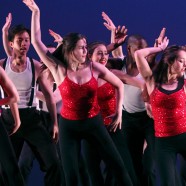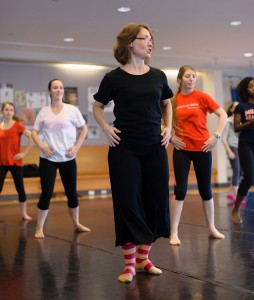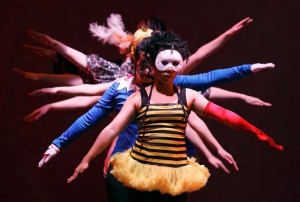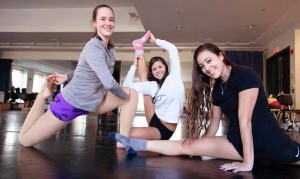
Excitement has been building for weeks, and not just among the dancers. Don’t count on talking your way into King Theatre without a ticket. The Winter Dance Concert may be the biggest draw all year on campus. Seats are “sold-out” for the three nights’ run.
Some students in the show have been dancing for many years; others made their way to dance tryouts after a football practice last fall. Milton choreographers figure prominently in the program lineup. These students, who earned green lights for their proposals from performing arts faculty last fall, have produced their dances for an audience of peers.
Kelli Edwards teaches dance, advanced dance and choreography courses at Milton. (Corey Baker ’03 and Kevin Moy ’05 are her teaching colleagues in the department.) Every year, Kelli’s advanced class—as a group—creates a single dance. “My role,” Kelli says, “is to ask the right questions to help them figure out what to do with their ideas—to act as a creative coordinator.”
 Beginning with a broad field of ideas, Kelli’s class eventually narrows the focus: from the violent, physical power of the Mafia, to the power of a group on an individual, for instance. To make progress, her students play music, listen, talk in tandem. “This is a messy, rambling stage,” Kelli says, “and the students are uncomfortable, not knowing where they’re going.”
Beginning with a broad field of ideas, Kelli’s class eventually narrows the focus: from the violent, physical power of the Mafia, to the power of a group on an individual, for instance. To make progress, her students play music, listen, talk in tandem. “This is a messy, rambling stage,” Kelli says, “and the students are uncomfortable, not knowing where they’re going.”
Once they’ve settled in, the class needs to conceptualize physical configurations that will represent their idea. “My students have an easier time generating thematic ideas—that process is a familiar one. They have a tougher time visualizing movement.”
Moving them in that direction “is tricky,” Kelli says. “You have to get them out of their heads. You find a seed, the more specific the better, and build that out. Students need a concrete place to start.” For this year’s class, the kernel that worked was the thought of a magnet: its power to attract and repel. That provided physical direction for improvisation, which leads to a movement phrase, which—with work—leads to intersecting movement phrases. From this flow, outside toward inside, then from inside back out, the dance emerges.
The student choreographers that Kelli mentors with the help of Kevin Moy are often interested in telling a story with the dances they create. Milton’s would-be choreographers submit proposals in October, two weeks before they hold auditions to choose dancers. With their dancers, they work together over second semester, culminating in the March concert.
Why choose choreography as your art form? Having always composed her own combinations of pliés and tendus, Grace Kernohan ’13 discovered in her Class III year that improvising moves—creating artistically interesting movement—was fun. She realized that she wanted to do more.
“For me,” says Isabel Wise ’13, a dancer since she was two years old, “movement is more successful than words in conveying a message. With dance, I can express myself more clearly, more effectively.”
Hayley Fish ’13, also a lifelong dancer, talks about the impetus to create dances that carry messages through stories. Hayley had been involved in dances that required high technical proficiency, but she had little choreography experience. “Here,” Hayley says, “Kelli is totally open to our ideas about everything: movement, costumes, lighting. The stage is our voice.”
The choreographers carry out their plans independently: they set the goals for their dancers; hold tryouts; run rehearsals (eight of them, two hours each); organize the teaching; respond to dancers’ feedback; track the progress; and often, dance a role themselves.
Hayley’s dance this year is intended to be a toy store coming to life. Her dance includes 24 dancers: 12 males (G.I. Joes) and 12 females (Barbie dolls). “I want my dance to draw the audience in, so they feel like they’re experiencing the shopping.” A family walks through the toy store (namely, Lisa Baker and Tarim Chung of the English department with their children) talking with one another. Each child walks away with her toy choices.
“I was intentionally not choosing the best technical dancers during tryouts,” Hayley says. “I needed dancers who could be more loose, more open. Seven of my dancers are on the football team. I was looking at their freestyle moves, the emotion on their faces, whether they could have fun with it. In the auditions, I looked for which boy could truly straighten his arm. Doing things in unison is key, and line changes are important. My dance isn’t highly technical but it’s dynamic; moves need to be done in unison.”
Isabel’s dance is more somber. Having experienced the deaths, recently, of two people close to her, Isabel created a tribute to them. The living, Isabel explains, are mourning. “I present what could be an idea of heaven; angels reach out, but there’s a divide.” As is the case with Hayley’s dance, the idea she wants to convey triggers the movements that she weaves together. “For instance,” Isabel explains, “I visited my grandmother often when she was sick and dying. In my dance, I adopted what my grandmother was doing with her hands when I would see her.”
Grace asserts that her dance, which explores the idea of infection, is intense rather than sad. “Five dancers are in black; four are in white. I’m using ‘tear-away’ costumes, so the white costumes tear away, revealing black beneath and emphasizing the idea of infection.” The costumes are what Grace calls a “draw-in component,” but she wants people to be excited about the dance itself. The dance should tell the story.
How do the girls work with their dancers, trained and untrained, to make sure that movement tells the story, independent of costumes, music and lighting?

The tech crew, eight students, manages sound, light and stage. The 15 dances on the full program this year will showcase 70 student dancers in total. Think of the costume changes happening offstage, in the first-floor rooms of Kellner Performing Arts Center.
Last year Hayley’s dance relied on technically advanced dancers. You could show them what an eight count looked like, and they’d do it. This year her troupe is completely new to dance. It was “very eye-opening for me,” Hayley says, “to see that some movements I thought were easy are not, especially for the guys. I have to break down every movement. I teach legs first, then arms, then legs faster, then arms faster, until it comes together.”
Isabel talks about having to find a balance. Instructors at the studio where she has studied are often very direct and severe. That doesn’t work with your peers. “I have to lean more on the respect side of the fear-and-respect tension,” Isabel says, “and I’m getting better at that.”
Grace uses metaphors to help her dancers “go beyond the movement itself,” she says. “I’ll say, ‘Cut it like a knife,’ or ‘Weed your way all the way up.’
“Anyone can lift his arm up, but I want him to bring it up with power and emotion. The metaphors help me get my message across to the dancers, as well as to the audience. If the dancers don’t perform with emotion behind their movements, the story will be lost in the dance.” Grace talks with individual dancers after the practice, not in front of the others. That’s a better time, she thinks, to tell a dancer to “flex her hand, rather than keeping it so pretty.”
Creative blocks do occur, before and during the eight-week rehearsal span. They can be painful, everyone agrees. Isabel finds inspiration from just watching other highly trained dancers; Grace likes to walk away from the music and then come back to it. Hayley often relies on videos of her older performances for new ideas. Kelli says that she will start with one of a number of physical exercises, hoping that it will generate ideas.
The time comes when the choreographers must rely on a combination of trust and just letting go, whether or not a work is “finished.” “After a certain number of run-throughs, the dancers need to see what they can do. You leave it to them,” says Hayley.
The dance is “always a mess” the first time dancers perform it onstage, during what’s known as “tech week,” just before the show. “You don’t have the mirror you’re used to, the stage is shaped differently from the studio floor, and you now have an audience,” Grace points out. “That moment of surprise eventually comes, when the dance has been performed, and you say, ‘Wow, I really did all that.’”
As Kelli says about her dancers and choreographers, these are young people trying to figure out the creative process. “They draw on what they know, and their expectations are based on what they’ve seen. What I’m trying to do is change their expectations of what they are doing, forcing them, and us, to create something fundamentally new.”
— Cathleen D. Everett
Click here to view slideshow of 2013 Winter Dance Concert




